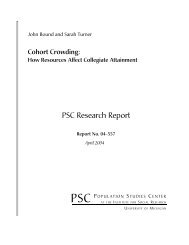Population Ageing and the Well-Being of Older Persons in Thailand ...
Population Ageing and the Well-Being of Older Persons in Thailand ...
Population Ageing and the Well-Being of Older Persons in Thailand ...
You also want an ePaper? Increase the reach of your titles
YUMPU automatically turns print PDFs into web optimized ePapers that Google loves.
Section 3: Demographic, Social <strong>and</strong> Economic Pr<strong>of</strong>ile<br />
Figure 3.9 exam<strong>in</strong>es whe<strong>the</strong>r gender <strong>and</strong> marital<br />
status is associated with <strong>in</strong>come <strong>in</strong>sufficiency <strong>and</strong><br />
f<strong>in</strong>ancial dissatisfaction. Nei<strong>the</strong>r gender nor marital<br />
status show an association with ei<strong>the</strong>r <strong>of</strong> <strong>the</strong>se<br />
measures. Analyses <strong>of</strong> national surveys conducted <strong>in</strong><br />
1994 <strong>and</strong> 1995 produced quite similar f<strong>in</strong>d<strong>in</strong>gs with<br />
respect to perceived economic well-be<strong>in</strong>g (Sobieszczyk,<br />
Knodel & Chayovan 2003). Thus while be<strong>in</strong>g <strong>in</strong> an<br />
<strong>in</strong>tact marriage is likely to provide important social<br />
support for an elderly person <strong>and</strong> may be critical for<br />
meet<strong>in</strong>g caregiv<strong>in</strong>g needs, it appears to confer little<br />
advantage with respect to <strong>the</strong> self perceived material<br />
well be<strong>in</strong>g <strong>of</strong> elderly Thais.<br />
to which those most <strong>in</strong> need receive government<br />
allowances compared to those least <strong>in</strong> need.<br />
Welfare allowance <strong>and</strong> f<strong>in</strong>ancial need. As discussed<br />
<strong>in</strong> Section 6 <strong>and</strong> as noted above, <strong>the</strong> government<br />
programme to provide modest allowances to <strong>in</strong>digent<br />
elderly persons <strong>in</strong> Thail<strong>and</strong> exp<strong>and</strong>ed considerably<br />
s<strong>in</strong>ce its found<strong>in</strong>g over a decade ago. Some local<br />
adm<strong>in</strong>istrations have liberalized qualifications <strong>and</strong> use<br />
supplementary local funds to provide broader or even<br />
universal coverage to resident elderly. Never<strong>the</strong>less it<br />
is important not to lose sight <strong>of</strong> <strong>the</strong> orig<strong>in</strong>al purpose<br />
<strong>of</strong> <strong>the</strong> programme to target those most <strong>in</strong> need <strong>of</strong><br />
f<strong>in</strong>ancial assistance. Figure 3.10, exam<strong>in</strong>es <strong>the</strong> extent<br />
Several different <strong>in</strong>dicators <strong>of</strong> <strong>the</strong> socio-economic<br />
status are used. Ra<strong>the</strong>r than show<strong>in</strong>g <strong>the</strong> full range <strong>of</strong><br />
each <strong>of</strong> <strong>the</strong> <strong>in</strong>dicators, only categories represent<strong>in</strong>g <strong>the</strong><br />
most <strong>and</strong> least favorable socio-economic situations are<br />
presented. <strong>Persons</strong> <strong>in</strong> <strong>the</strong> most favorable categories<br />
are considered to be least <strong>in</strong> need <strong>and</strong> those <strong>in</strong> <strong>the</strong><br />
least favorable most <strong>in</strong> need. The results clearly show<br />
that those most <strong>in</strong> need are far more likely to receive<br />
government allowances than those least <strong>in</strong> need.<br />
At <strong>the</strong> same time, it is also true that modest shares <strong>of</strong><br />
those who would appear to be least <strong>in</strong> need also<br />
receive such allowances. This may <strong>in</strong> part be a<br />
function <strong>of</strong> exp<strong>and</strong>ed programmes that target all or<br />
most elderly <strong>in</strong> some localities. Also for none <strong>of</strong> <strong>the</strong><br />
categories that would appear to <strong>in</strong>dicate greatest need,<br />
do a majority receive an allowance. Thus while <strong>the</strong><br />
results are encourag<strong>in</strong>g <strong>in</strong> show<strong>in</strong>g that <strong>the</strong> programme<br />
disproportionately helps elderly most <strong>in</strong> need, <strong>the</strong>re<br />
are likely still large numbers who sorely need<br />
f<strong>in</strong>ancial assistance but do not receive it.<br />
29















